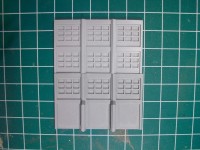While I'm working away on updating and restocking the last of the buildings from the Kickstarter, my thoughts turn to the future. The project has been quite a success so far, but I want to make things BIGGER! BETTER! SKULLIER!(?) And I need your help to do it!
There are some limitations to resin casting which effect the final product, and I'm debating the best way to work around them and provide you with the finest quality terrain for your games. I'd be really grateful if you could take a moment to give me some feedback about what you're looking for and what would make your game experience better.
(This post turned out super long so feel free to skip down to near the bottom where the good stuff is)
A Boring Primer on Resin CastingMolds for resin are made from silicone. It's fun stuff - easy(ish) to work with, fairly cheap, captures great detail, cheerful bubblegum pink color. The downside is it wears out as you use it, until eventually it needs replacing. But this process happens gradually every time you use the mold, and it means that the mold very slowly changes shape or size as it ages.
What this means is, two of the same part will not be exactly the same size if they came from molds with different "ages" (even if they're actually from the same mold!). This is a limitation of the material itself - any part, of any shape, made by anyone using a silicone mold will have this to some degree or another. For something like a figure or a garage kit, this usually isn't even noticeable. But for a building, with very straight, flat, regular parts that are all supposed to be exactly the same, it can become a problem.
Below is an example where I purposely chose parts that suffer from this. Because I needed fewer Upper Level parts, that piece is "younger" than the one on the bottom where the molds were used for longer:
Attachment:
 100_6348.jpg [ 597.72 KiB | Viewed 6039 times ]
100_6348.jpg [ 597.72 KiB | Viewed 6039 times ]
The difference isn't very much - even in this example where I deliberately picked parts that
don't match up well, my calipers inform me that the difference in length is only 0.8mm. But it's still noticeable, and would require some work on the part of the builder to make everything fit properly, especially when building a larger structure with more parts.
This was a problem during the Kickstarter, when I just had bins filled with parts that would vary like this and I had to carefully match up walls of similar size in order to assemble whole building kits. My newer production methods greatly reduce this, since from start to finish the parts from one mold pour stay together. If a part is defective, the whole building is rejected - its remaining good parts go into a "misfit" bin where I can match parts up into whole kits with much better results than during the Kickstarter.
However, while I can make sure that the parts within a single kit will work well together, it's much more difficult to ensure that parts from different kits will play nice. This is a problem anywhere that parts from more than one kit would be combined, such as people using their parts together to make larger structures - or for Upper Level kits and the like. I could solve this problem by combining a wall and its Upper Level into a single kit, so just like a regular building - the walls are just taller. But do people want that?
tl,dr: START HEREI'm worried that many people who are in the market are more interested in the flexibility of modular parts and want to build their own cool thing, even if that means more work and "hobby effort" put into making everything fit. Or do they? Maybe most gamers just want something they can plonk down and get to gaming...people still sell OOP Forge World buildings for big bucks on eBay even though mine are aimed at the same niche, so maybe what the market wants is a one-piece chunk of resin (but with a separate roof so the inside can be hollow; keep everything light to save on shipping).
What does the market want?
Any of your comments are great, but I'm most interested in which of the options below best matches what you're looking for in Epic-scale terrain, and why.Keep in mind that none of these options should imply a lower quality of casting, size or detail - if customers are interested in (for example) a big cathedral, that's something that I want to make look really cool regardless if it comes in five parts or fifty.
Option One: The "Gamer" OptionI want cool-looking terrain that's easy to get onto the tabletop. If the Forge World one-piece buildings were easily available, I'd buy those. If I'm going to spend hours and hours on a model, I want it to be a cool thing to destroy my opponent, not some elaborate custom building for him to hide behind.
Option Two: The "Keep Doing What You're Doing" OptionI'm fine with a little bit of assembly to put together terrain, but I like kits that work well "out of the box". Kind of like a Lego set: the parts work together best if you build the thing on the box, but if I want I can use them to make something different - it just might take some more work. I want to buy kits that fit together easily, but still give me the flexibility to modify or customize them.
Option Three: The "Wild West" OptionLimited-run resin kits where stuff takes some tweaking is par for the course for me. I don't care if I have to do some filing, cutting or modifying if it lets me build whatever crazy giant thing I have in mind. I'd rather be able to pick and choose from a wider variety of parts to buy, rather than have to purchase kits that come with stuff I don't really need for my awesome Nuclear Power Plant/Death Star/Dreamhouse model.
Thanks so much for reading and for your feedback!Cheers,
-Chris








 Stuff like that will likely lean more towards Option 1, since the multipart approach works best with flat, blocky buildings.
Stuff like that will likely lean more towards Option 1, since the multipart approach works best with flat, blocky buildings.